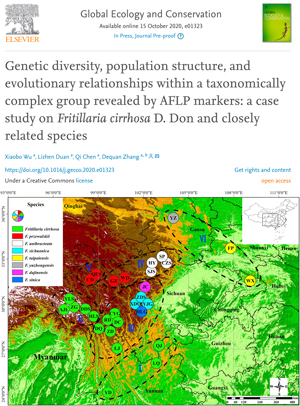NEWS 2020
Genetic diversity, population structure, and evolutionary relationships within a taxonomically complex group revealed by AFLP markers: a case study on Fritillaria cirrhosa D. Don and closely related species
Xiaobo WU1, Lizhen DUAN1, Qi CHEN1, Dequan ZHANG1,2
Global Ecology and Conservation (2020)
https://doi.org/10.1016/j.gecco.2020.e01323
1College of Pharmacy and Chemistry, Dali University, Dali, China
2Institute of Materia Medica, Dali University, Dali, China
Abstract
Fritillaria cirrhosa D. Don is an endangered perennial herb which has important medicinal properties. Because of its wide distribution and complex morphology, numerous closely related species were suggested to be F. cirrhosa, also due to obscure differences between species. These species, however, are also increasingly endangered due to overexploitation. So far, there are few systematic studies on population genetics of these species. Here, we used amplified fragment-length polymorphism markers to assess genetic diversity, population structures, and evolutionary relationships of F. cirrhosa and closely related species. We found that at species level, F. cirrhosa showed the highest genetic diversity (HSP = 0.2960), whereas F. dajinensis showed the lowest value (HSP = 0.1785). At population level, the mean value of genetic diversity was highest in F. unibracteata (HPOP = 0.2609) and was lowest in F. dajinensis (HPOP = 0.1785). In F. cirrhosa, the populations located in central distributions (HLS, DDS and DQ) produced the high genetic diversity, whereas the marginal populations (YD and QJ) showed little variation. Genetic differentiation among populations was relatively low (0.0622 to 0.1561) which was similar to molecular variance analyses showing only 19.15% variation between populations. The 30 initial populations were roughly assigned to six clusters, using an UPGMA dendrogram. The cluster containing F. cirrhosa was relatively complex and comprised multiple lineages. STRUCTURE and principal component analyses also supported the complex evolutionary relationships among species. We found that widely distributed species generally showed higher genetic diversity than more endemic species. Furthermore, F. cirrhosa populations in the central Hengduan Mountains were likely better protected, based on their substantially higher genetic diversity, compared to margin populations. This study provides reference for conservation and sustainable use of F. cirrhosa and closely related species.




